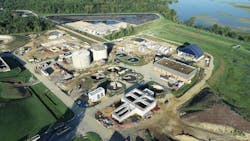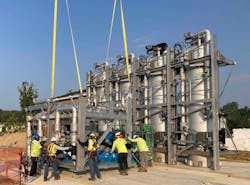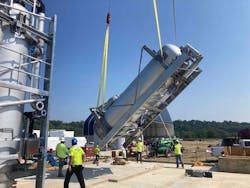About the author:
Dan Nawrocki is vice president for PC Construction. Nawrocki can be reached at [email protected].
In early 2019, WSSC Water — the water and wastewater utility serving Maryland’s Montgomery and Prince George’s counties — faced an emergency situation. Extensive rainfall in the area had completely saturated the ground, leaving the Piscataway Water Resource Recovery Facility in Accokeek, Maryland, at risk of being unable to land-apply its Class B biosolids to area farm fields.
With a key waste disposal outlet taken off the table, the utility was forced to start a plan to stockpile the material onsite.
“It just reinforced the fact that we had to find a better way,” said Theon Grojean, PE, and division manager of facility design and construction for WSSC Water.
Fortunately, the utility had begun its search 10 years earlier for a more efficient and sustainable method of waste disposal. Its 2009 study, which examined more than a 12 different options, led it to a thermal waste-processing technology, which at the time was largely being used in Europe.
The technology would accomplish two key goals:
- Reduce the amount of biosolid waste being produced; and
- Produce cleaner waste, which would open up more avenues for re-use and disposal.
An Innovative & Sustainable Solution
The solution that WSSC Water discovered in that early study, and ultimately chose to pursue, is a marriage of anaerobic digestion (AD) and thermal hydrolysis process (THP). The AD process essentially pressure-cooks the sludge, which drastically reduces the amount of biosolids in favor of methane gas production. While that process is not new, the addition of thermal hydrolysis dramatically improves its efficiency.
The combined system puts out far more methane, which is then converted to pipeline-quality renewable natural gas (rNG). Its potential uses include fueling buses, generating power, and even heating homes. In the case of the WSSC Water facility, the rNG can be sold on the open market. Additionally, WSSC Water will use the rNG to drive engine generators that produce electricity. Enough electricity, in fact, to power the entire operation. The anticipated net savings? More than $3 million a year.
At the end of the processing line, some solids remain, but they are of the much cleaner Class A variety, which can be used for residential purposes. Since Class A biosolids have been treated to eliminate pathogens and viruses, they can, with very little additional effort, be turned into lawn and garden fertilizer. (“You would think it was potting soil,” Grojean said.) In fact, once the new facility is closer to coming online, WSSC Water could look to develop a business plan for pelletizing and bagging its Class A product and selling it to consumers.
“This project is exceptional in the sense that it gets the most out of the waste stream,” said Robert Wierzbicki, project director for PC Construction, WSSC Water’s design-build partner on the project. “Here, we’re transforming a by-product that the utility used to have to truck off-site in large volumes while finding a nearby farm or landfill with enough capacity. Oh, and by the way – we’re transforming it into renewable energy.”
A Massive & Ground-Breaking Project
The $271 million project is, by far, the largest and most innovative project that WSSC Water has ever undertaken. Work began in September 2019, when PC Construction got underway with demolition, utility upgrades, and general site-preparation work. And work has continued, full steam ahead, throughout COVID-19. The project was deemed essential during the pandemic’s initial shutdown period, keeping hundreds of area construction personnel hard at work.
The PC team, partnering with Stantec and Hazen and Sawyer, designed the project to meet WSSC Water’s anticipated 2040 capacity. The new facility’s THP capacity could exceed 88 dry tons per day, and the project’s two digesters will have a combined volume/capacity of more than 3 million gallons.
The project is currently in Phase 2 of construction with overall completion scheduled for July 2024.
According to Wierzbicki, Grojean, and the project’s key vendor, Cambi, the Piscataway Bioenergy Project is one of just eight facilities in the U.S. that are either currently using thermal hydrolysis or are presently under construction with the technology specified.
In addition to processing its native sludge, the upgraded Piscataway facility will receive sludge from WSSC Water’s other four existing water resource recovery facilities, making WSSC Water the first utility in the country to apply the THP/AD technology on a regional scale. Its environmental and economic benefits will be felt throughout the entire 1000-square-mile Washington Suburban Sanitary District, serving the region’s 1.8 million customers for the next 100 years.
Economic & Environmental Benefits
“The Piscataway Bioenergy Project serves as a great example of how strategic investments in water infrastructure can strengthen our economy while also creating a cleaner and greener future,” said Carla A. Reid, WSSC Water general manager and CEO. “The largest and most innovative initiative we’ve ever undertaken, this project will transform sewage into renewable energy — helping us reduce greenhouse gas emissions, protect the Chesapeake Bay, and save our customers millions.”
While the project’s new processes will result in some areas of increased operating expenses, the savings will exceed the additional costs. The projected $3 million in annual cost-savings will only look better over time, as farm and landfill space becomes more scarce and waste disposal costs continue to rise.
While the reduction in greenhouse gas emissions is harder to quantify until the plant goes live, it is expected to be significant. Not only does the new process cut total biosolids volume in half, drastically reducing the trucking of materials off-site, its design also qualifies the utility to receive substantial renewable energy credits.
The Future of Wastewater
PC Construction’s Robert Wierzbicki predicts that THP/AD is where the majority of U.S. wastewater utility processes will head in the future.
“The design is really visionary, and it solves a lot of problems. Landfills are maxing out capacity. The costs of trucking and dumping solids is increasing substantially. Our environment is being affected by greenhouse gas emissions. And of course, electricity costs are getting higher and higher every day,” Wierzbicki said. “This technology addresses all of these issues in one shot.”



